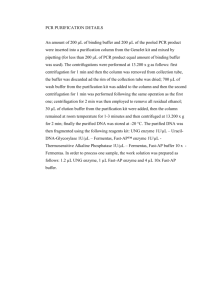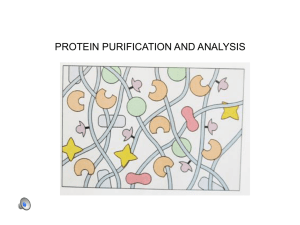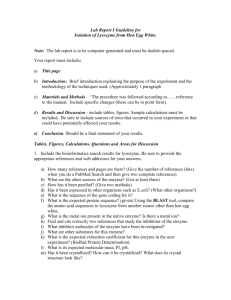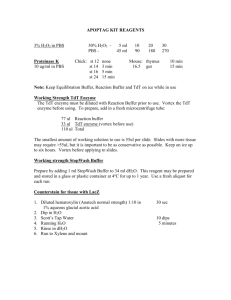horse liver alcohol dehydrogenase: new perspectives for an old
advertisement
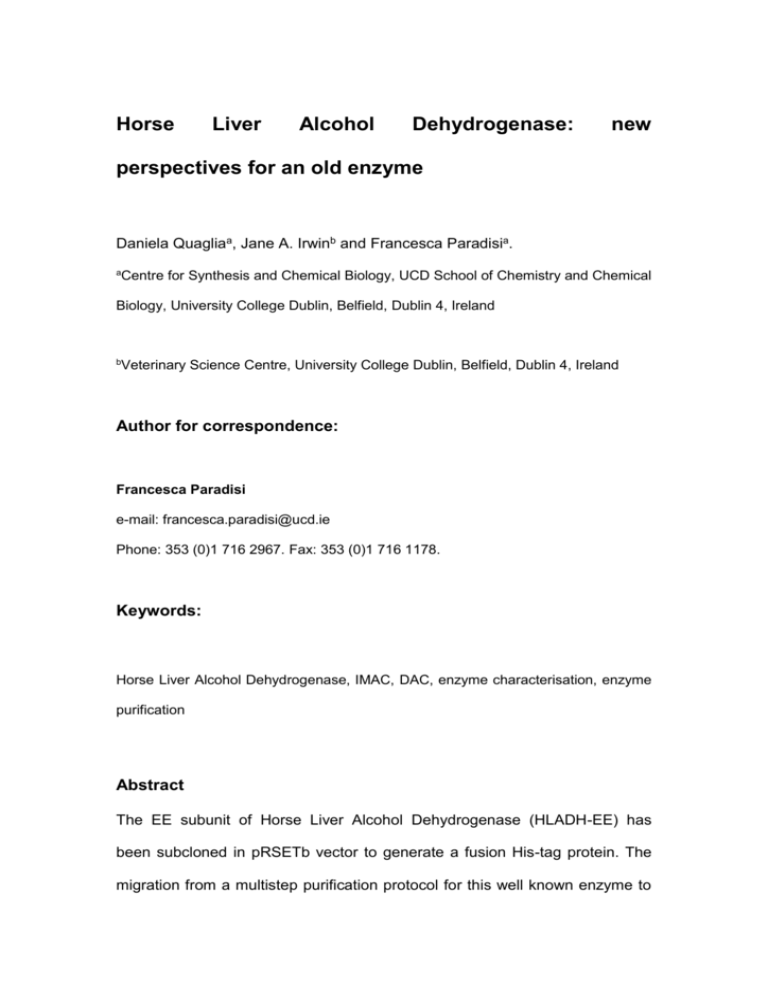
Horse Liver Alcohol Dehydrogenase: new perspectives for an old enzyme Daniela Quagliaa, Jane A. Irwinb and Francesca Paradisia. a Centre for Synthesis and Chemical Biology, UCD School of Chemistry and Chemical Biology, University College Dublin, Belfield, Dublin 4, Ireland b Veterinary Science Centre, University College Dublin, Belfield, Dublin 4, Ireland Author for correspondence: Francesca Paradisi e-mail: francesca.paradisi@ucd.ie Phone: 353 (0)1 716 2967. Fax: 353 (0)1 716 1178. Keywords: Horse Liver Alcohol Dehydrogenase, IMAC, DAC, enzyme characterisation, enzyme purification Abstract The EE subunit of Horse Liver Alcohol Dehydrogenase (HLADH-EE) has been subcloned in pRSETb vector to generate a fusion His-tag protein. The migration from a multistep purification protocol for this well known enzyme to a single step has been successfully achieved. Several adjustments to the traditional purification procedure for His-tag proteins have been made to retain protein activity. A full characterization of the fusion enzyme has been carried out and compared with the native one. The Km for EtOH, NAD and NADH in the his-tag version of HLADH are in line with the ones reported in literature for the native enzyme. A shift in optimal pH activity is also observed. The enzyme retains the same stability and quaternary structure as the wild type and can therefore be easily used instead of the native HLADH for biotechnological applications. 1. Introduction Horse Liver Alcohol Dehydrogenase (HLADH) is a widely studied enzyme. Its activity and structure are well known and it has been the subject of studies for many years [1] that are still ongoing. HLADH is a very good candidate for biocatalysis and the commercially available preparation (extracted from liver tissue as a mixture of EE, ES and SS dimeric isoforms) has been used in the past as a biocatalyst in several chemical reactions [2-4]. A recombinant form of the enzyme (EE isoform) has been reported by Park and Plapp in 1991 [5] but has never been tested in synthetic applications. A four-step purification protocol has been reported by the same group and no modification to it has been published since. To streamline such a procedure, Dye Affinity Chromatography (DAC) had also been attempted. The interaction between HLADH and several dyes, e.g. Cibacron Blue F3GA, has been investigated in the past [6] with various degrees of success [7, 8]. It is well known that a one-step purification is achieved by metal affinity chromatography where the protein of interest is fused with a poly-histidine tail [9]. This strategy is generally poorly suited to metallo-enzymes, as the use of chelating agents such as imidazole may irreversibly inhibit the enzyme as is the case for primary ADHs [10-12]. Nevertheless, in our laboratory we have previously optimized IMAC technology for the purification of His-tagged ADHs from halophiles [13]. When EDTA is used instead of imidazole, the required concentration is well tolerated by the enzyme. The application of the same methodology to His-tagged HLADH renders enzymatic production cheaper and quicker, making this enzyme even more appealing for biotechnological applications. 2. Materials and Methods 2.1. Materials, strains, vectors and culture conditions. All chemical reagents, unless otherwise stated, were purchased as analytical grade from Sigma-Aldrich. NAD+ was purchased from Apollo Scientific Ltd, Stockport, U.K. Restriction enzymes and protein markers were purchased from New England Biolabs (USA). Phusion DNA polymerase was purchased from Finnzymes (Finland). The QuickChange® XL Site-Directed Mutagenesis Kit was purchased from Agilent Technologies (USA). The High Pure PCR Product Purification Kit was purchased from Roche (Germany). GeneJET™ Plasmid Miniprep Kit was purchased from Fermentas (part of Thermo Fisher Scientific Inc., USA). Staining and destaining was performed using the Stain/DeStain-Xpress protein detection kit (Enzolve Technologies., Ltd., Ireland). E. coli NovaBlue competent cells, E. coli BL21 competent cells, pSTBlue-1 vector and pET21a vector were purchased from Novagen (Germany). The pRSETb vector was from Invitrogen (Biosciences, Dun Laoghaire, Ireland). E. coli XL10-Gold 151 Ultracompetent cells were purchased from Agilent Technologies (USA). The pBPP-EqADH-E vector was a kind donation from Prof. B. Plapp, Department of Biochemistry, University of Iowa, U.S.A. [5]. Sequencing was performed by Eurofins MWG Operon (Germany) for the pBPP-EqADH-E vector and by GATC Biotech (Konstanz, Germany) for the other constructs. Dye Affinity Chromatography small columns were kindly lent to us by Prof. Paul Engel (The Conway Institute, UCD, Dublin, Ireland). Transformed E.coli strains were generally cultured in Luria-Bertani (LB) agar and in LB broth, both containing ampicillin (100 μg/mL) at 37°C, shaking at 250 rpm. E.coli strains harbouring a pRSETb-EqADH-E vector were cultured in PG (minimal media) agar and in LB broth, both containing ampicillin (100mg/mL) at 37°C, shaking at 250 rpm. [14] 2.2. Construction of expression plasmids 1) pET21a-EqADH-E 2) pRSETb-EqADH-E 1) The pBPP vector harbouring the HLADH-E (GenBank accession no: 100034242) was pBPPHLADHfwd sequenced using the oligonucleotide ((51-TACTGAGTGGACGTACCTGG-31) primers and pBPPHLADHrvs (51-ATGCCCGCTGCCTCATGGCC-31). The HLADH-E gene was amplified from vector pBPP-EqADH-E by PCR using Phusion DNA polymerase. The oligonucleotide primers AAAACATATGAGCACAGCAGGAAAAG-31) and FWD-HLADH (51- RVS-HLADH (51- AAAAGAATTCGGGAAAGGTGACAGGATT-31) were designed to incorporate NdeI and EcoRI restriction sites, respectively (underlined). The gel-purified PCR product was cloned into pSTBlue-1 vector using the AcceptTor™ vector kit (Novagen, Germany) according to the manufacturer’s instructions. The resulting construct, designated as pSTBlue-1-EqADH-E, was used to transform E. Coli NovaBlue. A silent mutation to eliminate an internal NdeI restriction site was introduced using the oligonucleotide primers FWDHLADH-mut (51-TCATGCTGTCAAGAAGCGTATGGTGTGAGCGTCAT-31) and (51- RVS-HLADH-mut ATGACGCTCACACCATACGCTTCTTGACAGCATGA-31), where the mutation site is underlined. The QuickChange® XL Site-Directed Mutagenesis Kit was used. The resulting construct, designated as pSTBlue-1-EqADHEmut, was then used to transform E. coli NovaBlue. The construct pSTBlue-1EqADHE-mut was digested with NdeI and EcoRI and the gene was cloned into an NdeI/EcoRI digested pET21a vector. The resulting clone, designated as pET21a-EqADH-E, was propagated in E. coli XL10G prior to transformation in E.Coli BL21 competent cells. As a control, E. coli BL21 was additionally transformed with the empty vector, pET21a. 2) The HLADH-E gene was amplified by PCR from vector pBPP-EqADH-E using Phusion DNA polymerase. SacI An oligonucleotide primer FWD-HLADH- (51-AAAAGAGCTCGATGAGCACAGCAGG-31) was designed to incorporate a SacI restriction site (underlined) and RVS-HLADH primer mentioned above was used to introduce an EcoRI restriction site at the Cterminus. The gel-purified PCR product was cloned into a pSTBlue-1 vector using the AcceptTor ™ vector kit (Novagen, Germany) according to the manufacturer’s instructions. The resulting construct, designated as pSTBlue- 1-EqADH-E-bis, was used to transform E. coli NovaBlue. This construct was digested with SacI and EcoRI and the gene was cloned into a SacI/EcoRI digested pRSETb vector. The resulting clone, designated as pRSETbEqADH-E was propagated in E. coli XL10G prior to transformation in E. coli BL21 competent cells. As a control, E. coli BL21 was additionally transformed with the empty vector, pRSETb. In each case, successful cloning was confirmed by DNA sequencing. 2.3. Expression of HLADH-EE Two methods of expression were tested. The first method used IPTG induction and it was based on the original procedure [5]. LB broth (300 mL) containing 100 μg/mL ampicillin was inoculated with 5 mL of seed culture previously grown overnight, harbouring the expression plasmid pET21aEqADH-E. The culture was grown at 37°C, shaking at 250 rpm until an OD600 of around 0.6-0.8 was reached. Expression was then induced with IPTG (100 μg/mL) and the culture was allowed to grow for 4 hours at 37°C, shaking at 250rpm. Cells were harvested and stored frozen at -20 °C, until needed. The second method used the Auto Induction media ZYP-5052, as described by [14]. LB Auto Induction ZYP-5052 broth (300 mL) containing 100 μg/mL ampicillin was inoculated with 5 mL of seed culture, harbouring the expression plasmid pET21a-EqADH-E. The culture was shaken at 37°C for 15 hours and the cells were then harvested and stored frozen at -20 °C, until needed. Following protein production, cells were resuspended in 5 mM Na 2HPO4NaH2PO4 buffer, 0.25 mM EDTA, pH 7.8. Cells were disrupted by addition of lysozyme from egg white at a concentration of 0.35 mg/mL (30 minutes, gently shaking on ice) and by sonication, 4 °C, at intervals of 30 s until the lysate appeared transparent. After centrifugation (38000g, 4°C, 30 min) the supernatant was clarified by filtration and assayed for alcohol dehydrogenase activity. 2.4. Expression of His-HLADH-EE Freshly transformed E. coli strains, harbouring the pRSETb-EqADH-E vector, were cultured in minimal non inducing media (PG) agar plates [14]. A colony was then directly transferred into 300 mL of Auto Induction media ZYP-5052 [14] and the culture was grown for 15-20 hours at 37°C, shaking at 250 rpm. Cells were then harvested and stored frozen at -20 °C, until needed. Following protein production, cells were resuspended in Binding Buffer (20mM Na2HPO4-NaH2PO4, 0.5 M NaCl, 0.02 M imidazole, pH 7.4). Cells were disrupted by addition of lysozyme from egg white at a concentration of 0.35 mg/mL (30 minutes, gently shaking on ice) and by further sonication, at 4 °C, at intervals of 30 s until the lysate appeared clear. After centrifugation (38000g, 4 °C, 30 min) the supernatant was clarified by filtration and assayed for alcohol dehydrogenase activity. 2.5. Purification of HLADH-EE The supernatant from E.coli BL21 cells transformed with pET21a-EqADH-E was purified using DEAE-Sepharose ion exchange chromatography following the original procedure [5]. A screening for an alternative method of purification was also carried out using untested dyes by Dye Affinity Chromatography (DAC). Small samples of crude and purified HLADH-EE (volume ranging between 0.1 to 0.5 mL) where applied to different DAC columns: Procion Blue HBRD, Procion Blue MX-3G, Procion Blue MX-R, Procion Brown H-2G, Procion Brown MX-5BR, Procion Green H-E4BD, Procion Orange MX-2R, Procion Orange MX-G, Procion Red HE3B, Procion Red P-3BN, Procion Red MX-5B, Procion Scarlet MX-G, Turquoise H-7G, Turquoise H-A and Yellow MX-8G . All the columns were equilibrated with 5 mM Na2HPO4-NaH2PO4, 0.25 mM EDTA, pH 7.8 buffer and the protein was eluted with NaCl at a concentration ranging between 0.5 and 1 M. An attempt was also made to elute the protein using a NAD + containing buffer (5 mM NaPi, 0.25 mM EDTA, 100 µM NAD+, pH 7.8). The flow-through and the eluted fractions were checked for activity. The crude sample was prepared as described above, assayed for alcohol dehydrogenase activity and loaded onto the mini-columns. 2.6. Purification of His-HLADH-EE by Ni-IMAC The supernatant from E.coli BL21 cells transformed with pRSETb-EqADH-E was loaded at a flow rate of 0.5 mL/min onto a 1-mL His Trap™ FF Crude column pre-packed with Ni-Sepharose™ Fast Flow resin (GE Healthcare) and pre-charged with NiSO4 (0.1M). The column was equilibrated with 20 mM Na2HPO4-NaH2PO4 buffer, pH 7.4, containing imidazole (20 mM) and NaCl (2M). 20 mM NaPi buffer, pH 7.4, containing NaCl (0.5 M) was passed through the column until all non-specifically bound protein was removed. A stepwise elution was performed using 10 mM EDTA followed by 15 mM EDTA, in order to elute the His-tagged protein. The purification was monitored by UV absorption at 280 nm. Fractions (1 mL) were collected and assayed spectrophotometrically for alcohol dehydrogenase activity. Active fractions were analyzed by SDS-PAGE using 12% polyacrylamide gels, stained with Coomassie Brilliant Blue R250 [15]. A broad range protein marker, P7702S, (2-212 kDa) from New England BioLabs was used for determination of relative molecular weight. Crude protein concentration was determined using the Bradford protein assay dye reagent (Bio-Rad Laboratories GmbH, Germany) with bovine serum albumin as a standard [16]. Pure protein concentrations were determined by UV absorption at 280nm using the absorbitivities estimated from the amino acid composition data using ProtParam software [17], accessible from the Expasy website (www.expasy.ch) [18] (0.447 mL mg-1 cm-1 for HLADH-EE and 0.441 mL mg-1 cm-1 for His-HLADH-EE). Fractions selected on the basis of based on purity and specific activity were pooled and dialyzed overnight against 50 mM Tris-HCl buffer, pH 8.5. Purified His-HLADH-EE was routinely stored at 4 °C. 2.7. Size exclusion chromatography The molecular mass of the His-HLADH-EE protein was determined by size exclusion chromatography on a Superdex 200 high resolution 10/30 column with a total bed volume of 24 mL (GE Healthcare) equilibrated with 50 mM Na2HPO4-NaH2PO4 buffer, pH 7.8. Purified enzyme solution (100μL) was injected and the experiment was run at a flow rate of 0.2 mL/min. Protein molecular weight markers (Sigma Aldrich) used to prepare the calibration curve were β-amylase (200KDa), yeast alcohol dehydrogenase (150 KDa), bovine serum albumin (66KDa), carbonic anhydrase (29KDa) and cytochrome c (12.4 kDa), with blue dextran (2,000 kDa) being used to indicate the void volume. The samples for the calibration curve were run in 50 mM Na2HPO4NaH2PO4 buffer, pH 7.8. 2.8. Activity assays. Spectrophotometric activity measurements were based on the substratedependent absorbance change of NADH at 340 nm and routinely done in reaction mixtures (1 mL) at 25 °C, using a Varian Cary 50 Scan UV-visible spectrophotometer equipped with a Cary single cell Peltier temperature controller. Unless otherwise stated, the reaction mixture for the oxidative step contained NAD+ (1 mM), ethanol (8 mM) for the native HLADH-EE, ethanol (4 mM) for the His-HLADH-EE, enzyme sample (appropriate amount) and up to 1 mL of 0.1 M sodium pyrophosphate buffer, pH 8.8. The buffer was equilibrated at 25 °C prior to assay. One unit of HLADH corresponded to the amount of enzyme required to reduce 1 μmol of NAD+ per min at 25 °C. Kinetic data were fitted to the Michaelis-Menten equation using Sigma Plot. Measurements were obtained from two separate experiments. Errors are reported as standard deviations. For the pH stability test the following buffers were used: 50 mM Na2HPO4-NaH2PO4 buffer pH 6.5 and 7.5, 50 mM Tris-HCl buffer pH 8.5, 50 mM Glycine-NaOH pH 9.5. To investigate the optimum pH of reaction the following buffers were used: 50 mM Na2HPO4-NaH2PO4 buffer pH 6.5 and 7.5, 0.1 M pyrophosphate buffer pH 8.8, 50 mM Glycine-NaOH buffer pH 9.0 - 10.5, 50 mM Na2HPO4-NaOH buffer pH 11.0, 11.5. 50 mM Glycine-NaOH buffer, pH 9.5 was used to investigate the optimum reaction temperature and temperatures between 25 and 60 °C were tested. The pH values of the buffers were always adjusted at the temperature at which the experiment was carried out. 3. Results and discussion 3.1. Gene Cloning. EqADH-E was obtained in the pBPP vector [5]. The gene was subcloned into pET21a where expression is under the control of a strong T7 promoter to maximize protein production. As the gene itself contained an NdeI restriction site, optimal for cloning into pET21a, a silent mutation was successfully engineered to overcome the issue. The gene was first amplified by PCR and inserted in pSTblue-1 vector. The mutation was subsequently introduced and confirmed by sequencing. EcoRI and NdeI digestion allowed for the cloning into pET21a. For the creation of the fusion His-tag protein, the original gene was amplified and cloned into pRSETb in frame with the N-terminal 6xHis-tag. As the crystal structure of the native HLADH-EE is available, it was envisaged that the Histag would not have interfered with the core protein given that the N-terminal region of the protein is peripheral to the active site. 3.2. Expression of HLADH-EE and His-HLADH-EE While the use of IPTG or Auto Induction media ZYP-5052 gave similar results to those reported in the literature for the production of the native protein, auto induction was significantly better for the expression of His-HLADH-EE, particularly with the use of non-inducing minimal media PG agar plates. Activity was not detected in the crude extract of the His-HLADH-EE when IPTG was used as inducing agent. 3.3. Investigation of DAC as an alternative purification method for native HLADH-EE Several previously untested dyes were screened for the purification of HLADH-EE but the results were not particularly encouraging. SDS-page showed multiple bands and at best, only partial purification was achieved with Procion Blue MX-3G, Procion Blue MX-R, Procion Blue P-GR, Procion Green H-E4BD, Procion Red HE3B, Procion Red P-3BN (results not shown). 3.4. One-step purification of His-HLADH-EE His-HLADH-EE was purified in a single-step using IMAC with Ni2+ as the immobilized ion. Following purification, the purest, most active fractions were pooled together and dialyzed overnight to remove EDTA, known to have an inhibitory effect on zinc-dependent ADHs [19]. The expected 44 KD monomer was visualized by 12% SDS-PAGE (Fig 1). 66.4 55.6 42.7 34.6 27.0 His-HLADH-EE Fig. 1: SDS-PAGE visualization of His-HLADH-EE. Lane 1 (left) broad range protein marker P7702S, (2-212 kDa), Lane 2 (centre) pooled purified HisHLADH-EE fractions after dialysis, Lane 3 (right) crude protein extract. Molecular masses in kDa are indicated on the left. An arrowhead indicates the position of His-HLADH-EE. The specific activity of the protein was measured up to 1.7 U/mg with a protein concentration generally between 0.5 mg/mL and 1 mg/mL after dialysis. The specific activity of the crude lysate was a maximum of 0.07 U/mg giving, on average, 15-fold purification. These results are comparable to the ones reported in literature for the native enzyme [5] confirming that no loss of activity is detected by the addition of a His-tag. On average from our strategy we would obtain 8-10 mg of pure protein from 300 mL culture. The molecular mass of the His-HLADH-EE was estimated to be 90 KD from the size exclusion chromatography experiment. The quaternary structure is therefore not affected by the tag and remains a dimer (theoretical value: 88KD). 3.5. Characterization of His-HLADH We compared the properties of the native HLADH-EE enzyme to the polyhistidine-tagged one. Studies were carried out on the extinction coefficient and the quaternary structure of His-HLADH-EE and compared to the values reported in literature for HLADH-EE. No comprehensive study is reported in literature on the stability and the activity of the native HLADH-EE in relation to pH and temperature. Here we have also compared the behaviour of the one of the two recombinant enzymes. 3.5.1 Kinetics parameters The kinetic parameters for HLADH-EE have been published [20-22]. At pH 9, the Km NAD+ EtOH is reported to be between 0.35 mM [20] and 0.8 mM [21], the Km between 0.0039 mM [20] and 0.036 mM [21], and Km NADH between 0.0016 mM [22] and 0.0066 mM [21]. For this paper kinetic data were obtained at pH 8.8 in pyrophosphate buffer as an average of three (for ethanol and NAD+) and two (for NADH) independent experiments and are reported in table 1. Provided that all the previously reported values are correct, it appears that the His-tag HLADH-EE does not significantly alter the affinity for various substrates. Admittedly, the Km NAD+ is at the upper end of the scale closer to the value reported by Plapp in 1970 [21]. Kinetic parameters for His-HLADH Ethanol NAD+ NADH Km (mM) 0.263 ± 0.030 0.026 ± 0.004 0.006 ± 0.003 Vmax (U/mg) 0.77 ± 0.05 0.80 ± 0.19 2.45 ± 0.47 Table 1: Experimentally calculated Km and Vmax for His-HLADH-EE towards ethanol, NAD+ and NADH. Values are the average of three (for ethanol and NAD+) and two (for NADH) independent experiments and errors are reported as standard deviations. 3.5.2. pH stability and consideration of isoelectric point HLADH-EE has been routinely stored in 5 mM Na2HPO4-NaH2PO4, 0.25 mM EDTA, pH 7.8 buffer [5]. Using the Protein Identification and Analysis tool, available from the Expasy website (http://www.expasy.ch), the pI values of the two proteins are calculated as 8.31 for HLADH-EE and 7.54 for the Histagged enzyme [23]. To minimize the chances of protein precipitation the selected storage buffer should be at a different pH than the pI and, as such, a pH of 7.8 may not have been suitable for the His-tag protein. We performed accelerated stability experiments on both the enzymes at 37 °C at the following pH values: 6.5, 7.5, 8.5, 9.5. Data were collected from two sets of experiments over 48 hours and it was observed that 85% of the activity was retained at all pH values except pH 6.5, for which rapid inactivation was recorded (His-tag HLADH-EE loses of 50% of activity after 15 hours, significantly quicker than the native enzyme which reaches the same point at the end of the incubation period). The best pH for storage was 8.5 with 95% activity remaining after the incubation period. No significant variation, apart from pH 6.5, was detected between the two enzymes despite the different pI values. Routinely storing the enzyme at lower temperatures showed that HisHLADH-EE retained 40% activity after 80 days of incubation both at room temperature (23 °C) and at 4 °C, mimicking the behaviour of the HLADH-EE enzyme. 3.5.3. Optimum pH and temperature The oxidative reaction involving HLADH-EE and ethanol (and several other ADHs) is often carried out at pH 8.8 in 0.1 M pyrophosphate buffer, also in preparative methods (Sigma) [19], yet no comprehensive study showing how the activity of the enzyme varies with pH is reported in the literature. Furthermore the choice of pyrophosphate would seem quite unusual and buffers like Tris-HCl or Gly-NaOH are more commonly used at pH 8.8. The activity data follow a bell shaped curve for both HLADH-EE and HisHLADH-EE, with an optimum pH of 9.5 in 50 mM Glycine-NaOH buffer for HLADH-EE and pH 8.8 in 50 mM Glycine-NaOH buffer for the His tag enzyme (Fig 2). At pH 8.8 two buffers were compared: 0.1 M pyrophosphate buffer and 50 mM Glycine-NaOH buffer. Interestingly, the enzymatic performance in the Glycine buffer was in both cases almost 30% higher than in pyrophosphate. The activity reported in the graph for pH 8.8 is that obtained in Gly-NaOH. Fig. 2: A plot of pH against percentage activity of the native form and HisHLADH-EE. 100% represents the maximum activity and it corresponds to buffers 50 mM Glycine-NaOH pH 8.8 for His-HLADH-EE (0.6 U/mg) and 50 mM Glycine-NaOH pH 9.5 for HLADH-EE (0.4 U/mg). The optimum temperature for activity for the native and the His-tagged enzyme were compared (Fig. 3). The activity linearly increased with increasing temperature (25 °C to 60 °C), with over 2-fold increase for HLADHEE and 1.5-fold for His-HLADH-EE, considering the activity at 25 °C for each enzyme as 100%. At 70°C the UV traces were no longer reliable, probably due to ethanol evaporation and enzyme instability. Fig. 3: A plot of the specific activity (S.A.) of HLADH-EE and His- HLADH-EE against temperature. Data were fitted with a linear function (equation is shown in the graph. Conclusions In this work we expressed both recombinant native HLADH-EE and Histagged HLADH-EE. The introduction of the His-tag allowed for enzyme purification in one-step by metal affinity chromatography. A stability study was performed, and pH and T optima for the oxidative reaction were determined. We demonstrated that the His-tagged enzyme has comparable activity and stability at different pHs and temperatures to the native one with a minimal shift in optimal pH (9.5 for the native enzyme and pH 8.8 for the tag enzyme). Even though HLADH is a Zn dependent enzyme, the His-tag seems not to deeply affect its stability, which is optimal at pH 8.5 in Tris-HCl buffer. Acknowledgements The Irish Research Council for Science, Engineering and Technology (IRCSET) supported this work. We would like to thank Prof. B. Plapp (U.S.A.) for kindly providing the pBPP vector harbouring EqADH-E gene. We would like to thank Dr. Gabriele Gucciardo (UCD) for his constant support, Miss. Cleménce Pinchedé and Miss Zowie Reid for their contribution to the DAC and temperature optimum experiments. References 1. Brändén, C. I. and Jörnvall, H. (1975) Alcohol Dehydrogenases. Academic Press, 103-190. 2. Galletti, P. and Emer, E. (2010) Chemoenzymatic synthesis of (2S)-2-arylpropanols through a dynamic kinetic resolution of 2-arylpropanals with alcohol dehydrogenases, OBC 8: 4117-4123. 3. Galletti, P. and Pori, M. (2010) One-Step Oxidation of 2-Arylpropanols to 2-Arylpropionic Acids: Improving Sustainability in the Synthesis of Profens, Synlett 17: 2644-2648. 4. Giacomini, D. and Galletti, P. (2007) Highly Efficient Asymmetric Reduction of Arylpropionic Aldehydes by Horse Liver Alcohol Dehydrogenase through dynamic kinetic resolution, Chem. Commun.: 4038-4040. 5. Park, D. and Plapp, B. (1991) Isoenzymes of horse liver alcohol dehydrogenase active on ethanol and steroids. cDNA cloning, expression, and comparison of active sites., J. Biol. Chem. 266: 13296-13302. 6. Subramanian, S. (1984) Dye-ligand affinity chromatography: the interaction of Cibacron Blue F3GA with proteins and enzymes., CRC 16: 169-205. 7. Clonis, Y. D. and Labrou, N. E. (2000) Biomimetic dyes as affinity chromatography tools in enzyme purification., J. Chromatog. A 891: 33-44. 8. Lowe, C. and Lowe, A. (2001) New developments in affinity chromatography with potential application in the production of biopharmaceuticals, JBBM 49: 561-574. 9. Jerker, P. (1992) Immobilized metal ion affinity chromatography, Protein. Expr. Purif. 3: 263-281. 10. Dahl, K. H. and McKinley McKee, J. S. (1981) The Imidazole‐Promoted Inactivation of Horse‐Liver Alcohol Dehydrogenase, FEBS 120: 451-459. 11. Boiwe, T. and Brändén, C. I. (1977) X-ray investigation of the binding of 1,10phenanthroline and imidazole to horse-liver alcohol dehydrogenase, Eur. J. Biochem 77: 173179. 12. Egashira, T. and Waddell, W. J. (1984) Histochemical localization of primary and secondary alcohol dehydrogenases in whole-body, freeze-dried sections of mice., Histochemical J. 16: 931-940. 13. Timpson, L. M. and Alsafadi, D. (2012) Characterization of alcohol dehydrogenase (ADH12) from Haloarcula marismortui, an extreme halophile from the Dead Sea., Extremophiles : life under extreme conditions 16: 57-66. 14. Studier, F. (2005) Protein production by auto-induction in high-density shaking cultures, Protein. Expr. Purif. 41: 207-234. 15. Laemmli, U. K. (1970) Cleavage of Structural Proteins during the Assembly of the Head of Bacteriophage T4, Nature 227: 680-685. 16. Marion M, B. (1976) A rapid and sensitive method for the quantitation of microgram quantities of protein utilizing the principle of protein-dye binding, Anal. Biochem. 72: 248-254. 17. Walker, J. M. (2005) The proteomics protocols handbook. Humana Pr Inc, 988. 18. Gasteiger, E. (2003) ExPASy: the proteomics server for in-depth protein knowledge and analysis, Nucleic Acids Res. 31: 3784-3788. 19. Vallee, B. L. and Hoch, F. L. (1957) Zinc in horse liver alcohol dehydrogenase, J. Biol. Chem. : 185-195. 20. Dworschack, R. T. and Plapp, B. V. (1977) Kinetics of native and activated isozymes of horse liver alcohol dehydrogenase., Biochemistry-US 16: 111-116. 21. Plapp, B. (1970) Enhancement of Activity of Horse Liver Alcohol Dehydrogenase by Modification of Amino Groups at Active Sites, J. Biol. Chem. 245: 1727-1735. 22. Dalziel, K. (1963) Kinetic studies of liver alcohol dehydrogenase and pH effects with coenzyme preparations of high purity., J. Biol. Chem. 238: 2850-2858. 23. Wilkins, M. R. and Gasteiger, E. (1999) Protein identification and analysis tools in the ExPASy server., Methods in molecular biology (Clifton, N.J.) 112: 531-552.
